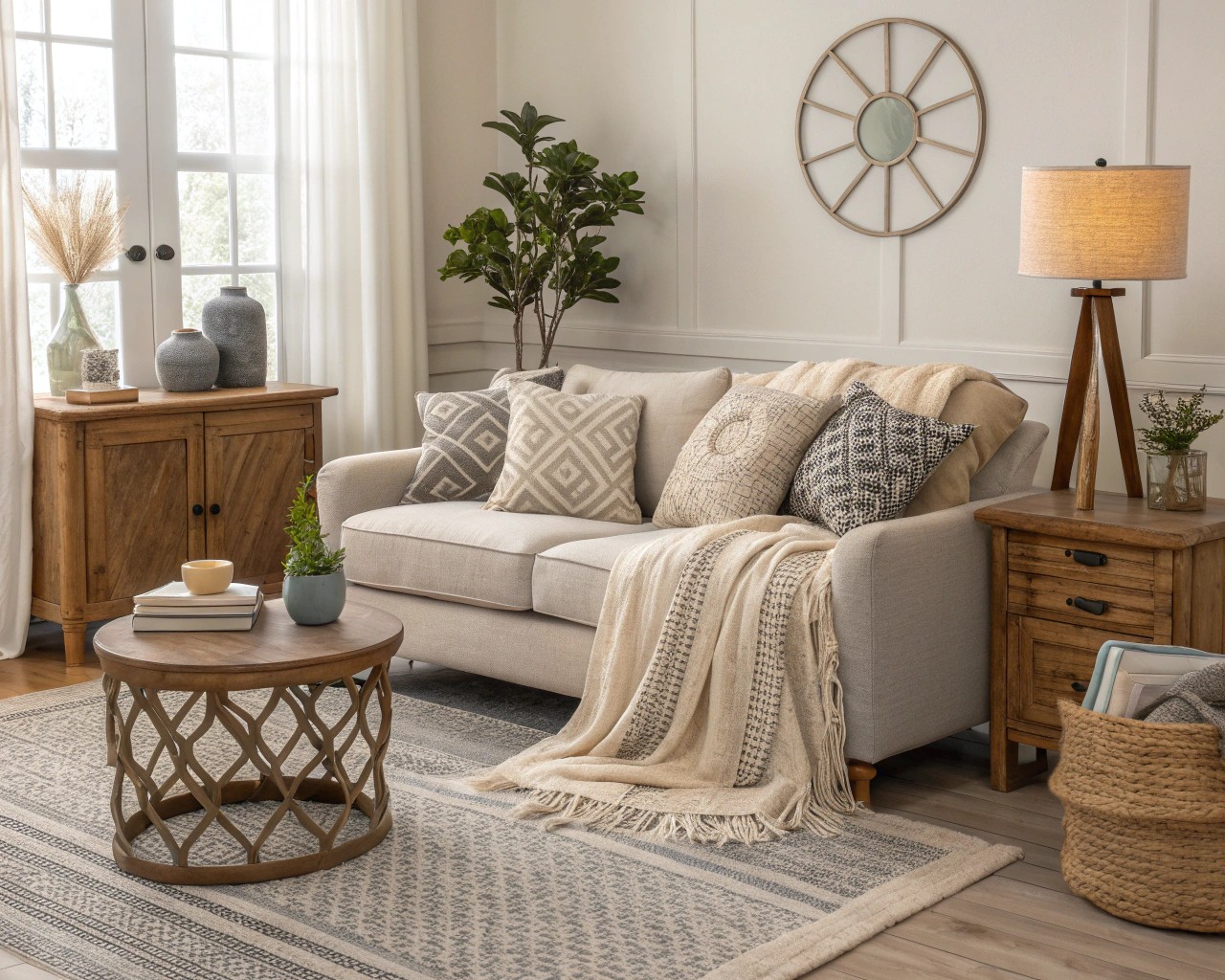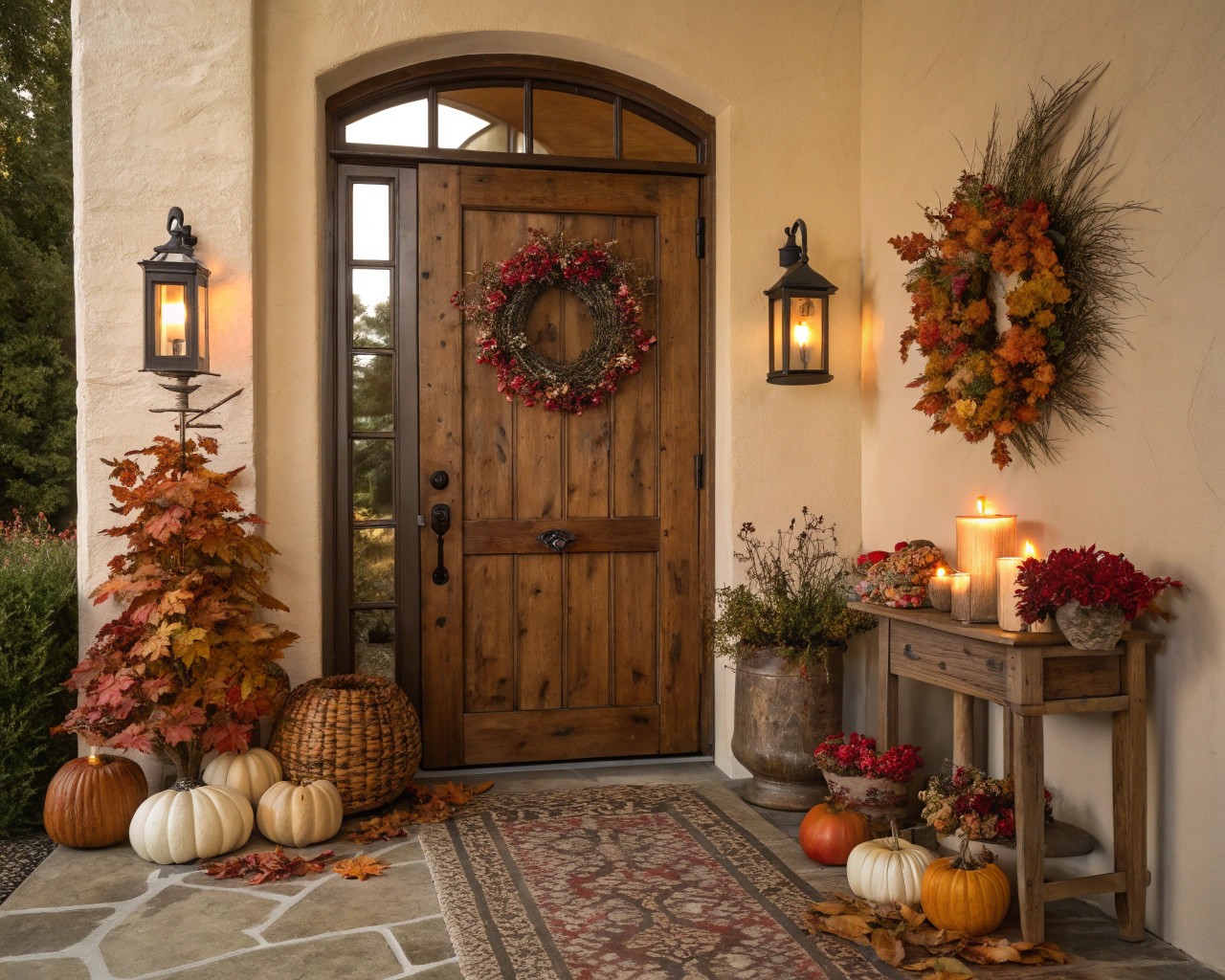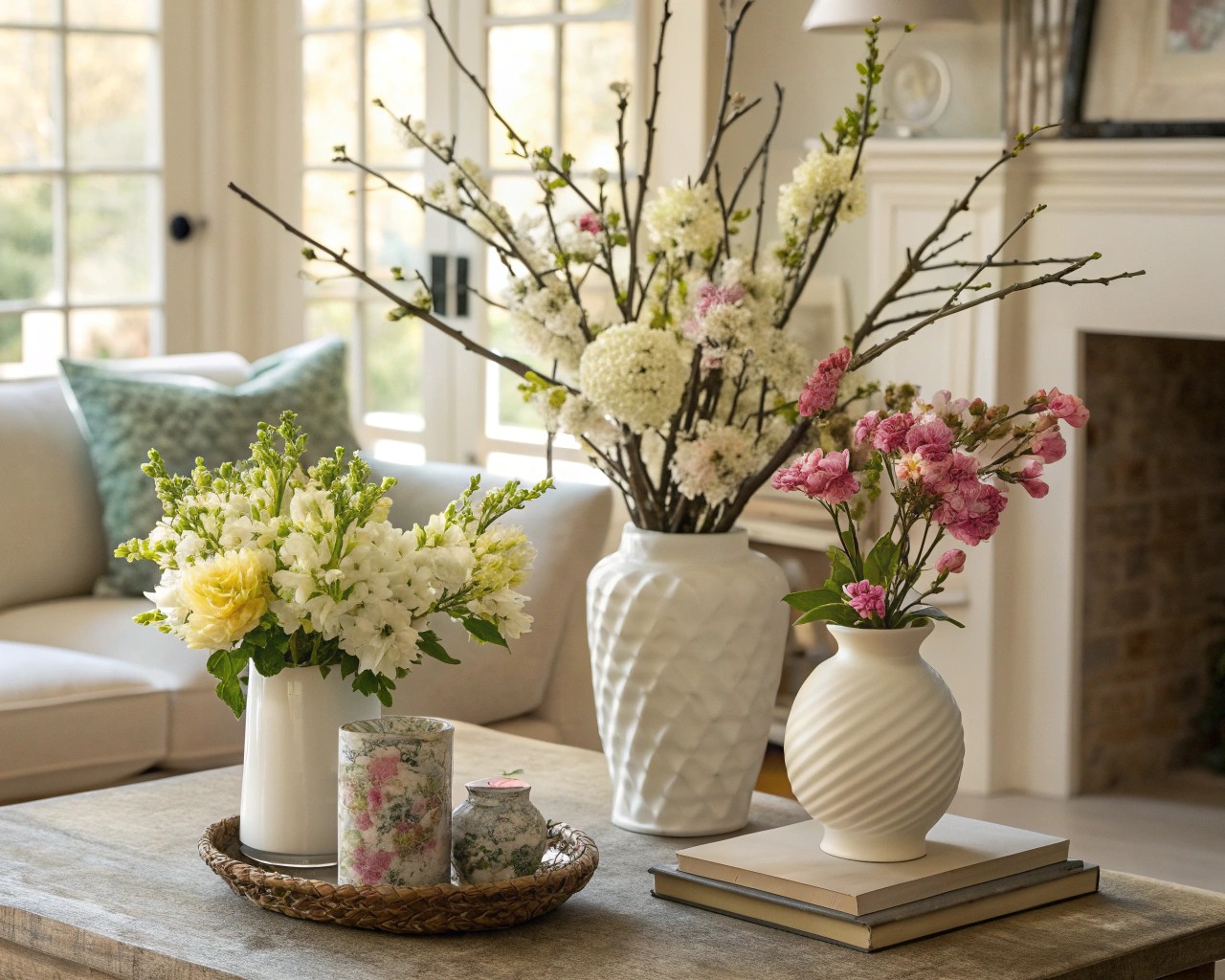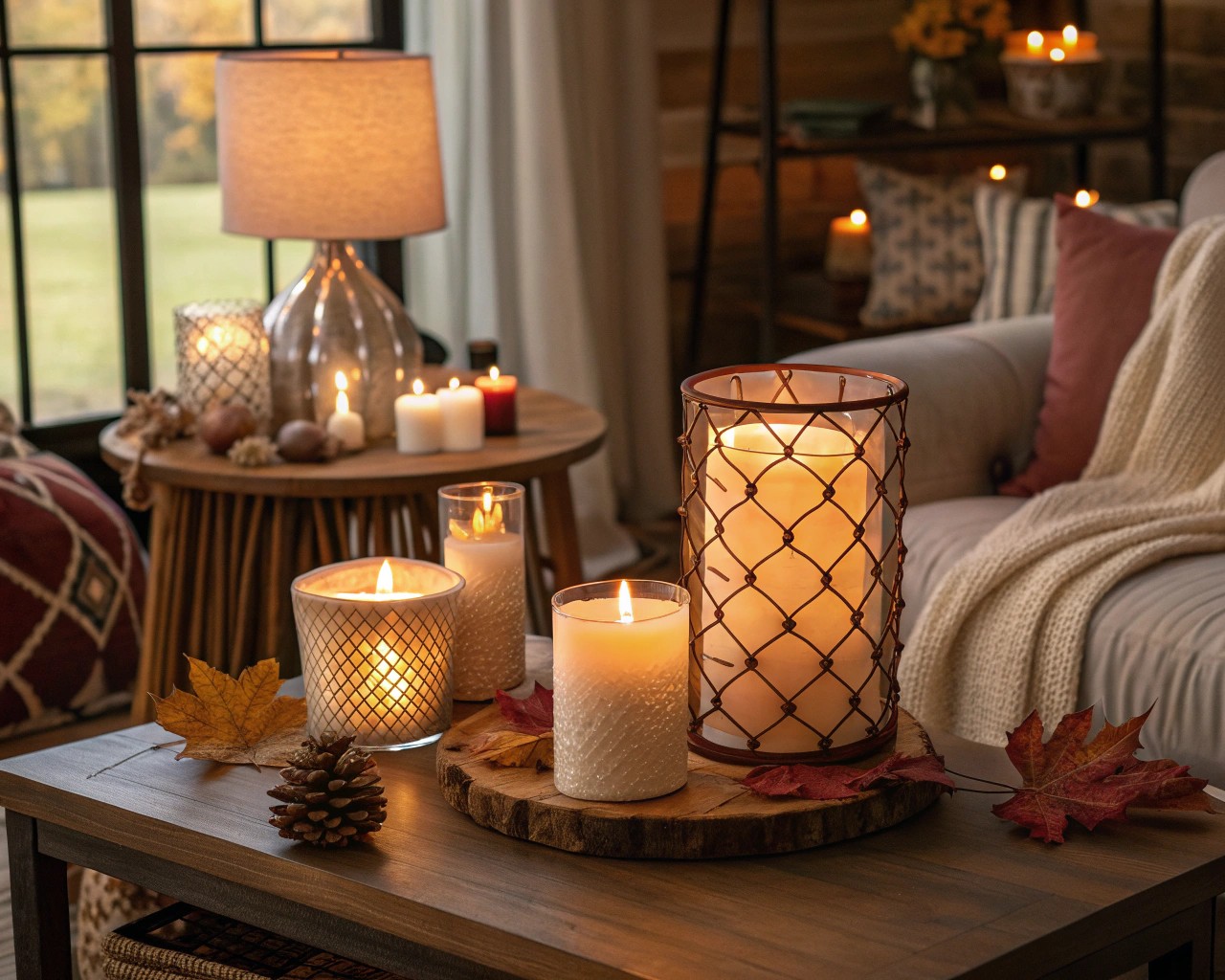When I walk into a home that shifts gracefully with the seasons, I can feel the difference immediately. It’s not about elaborate theme changes or costly overhauls—it’s about creating a living space that breathes with the natural rhythm of the year, reflecting the light, temperature, and energy unique to each season.
Understanding the Foundation: Building a Transitional Base

The most successful seasonal decorating begins with what designers call a transitional base—a neutral foundation that allows you to layer and swap elements without fighting against your existing design. I always start by establishing this groundwork with my own projects, selecting a palette of warm whites, soft beiges, greiges, or gentle grays that can accommodate the shifting tones of spring pastels, summer brightness, autumn warmth, and winter depth.
This approach isn’t about bland uniformity. Rather, it creates a sophisticated canvas that lets seasonal accents truly shine. Think of your walls, larger furniture pieces, and permanent fixtures as the stage, while your seasonal elements become the performance that changes throughout the year.
The Five Key Areas to Refresh Seasonally

Through years of designing residential spaces, I’ve identified five high-impact zones that deliver the most dramatic transformation with minimal effort:
Living Room
The living room serves as your home’s primary gathering space, making it essential for seasonal updates. I focus on textiles here—throw pillows, blankets, and sometimes area rugs. For spring and summer, I swap heavy velvets and wool throws for lightweight cotton, linen, or percale fabrics in cooler tones. When autumn arrives, I reintroduce chunky knits, boucle textures, and mohair accents in deeper, earthier hues like terracotta, forest green, or warm brown.
The transformation happens through texture as much as color. In fall, layering becomes paramount—think of adding a sheepskin at the foot of a chair, draping a chunky woven throw over the sofa arm, or introducing wool-blend cushions. These tactile additions create visual depth while literally warming the space.
Bedroom
Your bedroom deserves particular attention for seasonal transitions, as bedding directly affects sleep quality and comfort. I recommend maintaining two distinct bedding collections: one for warmer months (spring/summer) and another for cooler seasons (fall/winter).
For spring and summer, prioritize breathable fabrics with lower thread counts that promote air circulation. Percale cotton and linen excel here, offering crisp, cool surfaces perfect for warm nights. Choose lighter colors—soft whites, pale blues, or blush tones—that psychologically reinforce the airy feeling.
As temperatures drop, transition to flannel, heavier cotton weaves, or patterned sheets in deeper tones. The visual weight of darker, richer bedding—think charcoal, deep green, or warm burgundy—creates an immediate sense of coziness. Layer with additional quilts or duvets, and don’t overlook the transformative power of adding a textured throw or area rug beside the bed for physical warmth.
Dining Room and Tabletop Displays
The dining table offers perhaps the most versatile canvas for seasonal expression. I change centerpieces and table linens regularly, using runners or placemats that can be swapped seasonally while maintaining year-round dinnerware.
Spring centerpieces might feature fresh tulips, hyacinths, or branches of flowering quince in simple glass vases. Summer calls for bright, bold arrangements—sunflowers, daisies, or even a bowl of fresh citrus fruit. Autumn invites natural elements: arrange pumpkins, gourds, pinecones, and warm-toned florals like chrysanthemums or dahlias on a wooden tray or dough bowl. Winter centerpieces benefit from evergreen branches, white flowers, pinecones, and the warm glow of grouped candles in varying heights.
Entryway
Your entryway establishes the first impression and deserves thoughtful seasonal attention. I keep certain foundational pieces constant—a console table, mirror, and perhaps permanent lighting—then layer seasonal elements around them.
For practical seasonal transitions, consider storage solutions that accommodate changing weather needs. In fall and winter, incorporate baskets for scarves and gloves, hooks for heavier coats, and a more substantial doormat to handle moisture and debris. Spring and summer allow for lighter, more decorative elements—a seasonal wreath, fresh flowers in a vase, or a decorative bowl for keys paired with a simple coir mat.
Powder Room
This small, high-traffic space offers easy seasonal updates with significant impact. I rotate hand soaps, guest towels, and small floral arrangements to match the season. In December, peppermint-scented soap with forest green towels creates instant seasonal atmosphere; by April, a lavender soap with soft linen towels in pale pink signals spring’s arrival.
The Science of Seasonal Color Palettes

Understanding color psychology enhances your seasonal transitions considerably. Our physiological and psychological responses to color shift with environmental changes, making seasonal palette adjustments feel instinctively correct.
| Season | Primary Colors | Psychological Effect | Application |
|---|---|---|---|
| Spring | Pastels (soft green, peach, lavender, sky blue) | Renewal, clarity, energizing | Pillows, fresh florals, lightweight textiles |
| Summer | Bright, vibrant (yellow, coral, seafoam, white) | Cheerful, airy, expansive | Light fabrics, citrus accents, coastal elements |
| Fall | Warm earth tones (rust, mustard, deep green, brown) | Grounding, comforting, rich | Textured throws, natural elements, warm metals |
| Winter | Deep jewel tones or crisp whites (navy, burgundy, forest green, silver) | Cozy, intimate, elegant | Plush fabrics, metallic accents, evergreen elements |
I don’t advocate for complete color overhauls each season. Instead, I introduce seasonal hues through smaller, easily changeable elements—throw pillows, vases, candles, or artwork—while maintaining your neutral base.
Harnessing Natural Elements Throughout the Year

One of my most reliable design principles involves bringing the outdoors inside, and this approach adapts beautifully to seasonal transitions. Natural elements offer authenticity that manufactured decorations cannot replicate, and they connect your interior environment to the changing landscape outside.
Spring: Incorporate fresh botanicals—budding branches, potted bulbs, and early-blooming flowers like forsythia or pussy willow. I particularly love forcing branches indoors in late winter; pruning witch hazel, flowering quince, or magnolia and placing them in water encourages early blooms that fill rooms with fragrance and visual impact.
Summer: Display fresh-cut flowers weekly, incorporate seashells or driftwood for coastal references, and use herbs like rosemary or lavender in arrangements for both visual appeal and natural fragrance.
Fall: Gather pinecones, acorns, and colorful leaves from your yard for free, biodegradable decorations. Dried grasses, wheat stalks, and preserved hydrangeas offer texture and warm tones. Small pumpkins and gourds arranged in wooden bowls or stacked on mantels create classic autumn vignettes.
Winter: Evergreen branches (pine, cedar, fir) bring forest fragrance and deep green color indoors. Holly sprigs, pinecones, and bare branches arranged in tall vases create elegant, minimal displays. For extended life, mist evergreen arrangements regularly and keep them away from heat sources.
Strategic Lighting Adjustments

Lighting significantly affects how we perceive seasonal changes, yet it’s often overlooked in decorating discussions. I adjust both natural light management and artificial lighting as seasons shift.
During spring and summer, maximize natural daylight by opening window treatments and using sheer, light-colored curtains that diffuse harsh sunlight while maintaining brightness. Choose light bulbs with cooler color temperatures (3000K-4000K) that mimic daylight, creating an airy, expansive feeling.
As fall arrives, begin transitioning to warmer light (2700K-3000K) that creates amber, cozy glows. Rely more heavily on table lamps, floor lamps, and candles to create intimate pools of light rather than bright overhead fixtures. This layered lighting approach mimics the earlier sunsets and longer evenings characteristic of autumn and winter.
Install dimmer switches if possible—they’re invaluable for seasonal adjustments, allowing bright light during long summer days and softer ambiance during winter evenings.
Window Treatment Strategies for Energy Efficiency
Window coverings serve dual purposes: aesthetic appeal and practical climate control. I recommend different approaches for warm and cool seasons.
Cool Weather Strategy: Heavy, lined drapery in darker colors provides insulation, preventing heat loss through windows. Cellular shades with their honeycomb structure trap air, creating thermal barriers that can reduce heat loss by up to 40%. Keep treatments closed at night to retain warmth, but open them during sunny winter days to allow passive solar heating.
Warm Weather Strategy: Solar shades and light-filtering fabrics block heat gain while maintaining views, reducing indoor temperatures by blocking 80-90% of solar heat. Light-colored treatments reflect rather than absorb heat. Motorized shades scheduled to lower during peak sun hours offer effortless temperature management.
The Department of Energy confirms that proper window treatment management can reduce heat gain or loss by up to 77%, translating to significant energy savings.
Scent as Seasonal Architecture
While often considered secondary, scent profoundly influences our perception of seasonal atmosphere. I incorporate fragrance rotation into my seasonal design strategy, understanding that our olfactory preferences shift with the calendar.
Spring Scents: Fresh florals (jasmine, orange blossom), green notes (eucalyptus, fresh-cut grass), and light citrus (lemon, grapefruit) evoke renewal and cleanliness.
Summer Scents: Bright citrus (lime, bergamot), coastal notes (sea salt, coconut), and herbal fragrances (mint, basil) create energizing, breezy atmospheres.
Fall Scents: Warm spices (cinnamon, clove), earthy woods (sandalwood, cedar), and harvest notes (apple, pumpkin) provide grounding comfort.
Winter Scents: Evergreen (pine, fir), vanilla, warm musk, and peppermint offer cozy, festive ambiance.
Practical Implementation Tips:
- Store off-season candles and diffusers in cool, dark places to maintain potency
- Use “transitional scents” between seasons—citrus-spice blends work beautifully between summer and fall
- Layer fragrance methods (candles, diffusers, room sprays) for depth
- Rotate weekly within a season to prevent olfactory fatigue
Practical Storage Solutions for Seasonal Rotation
Effective seasonal decorating requires organized storage systems. Without proper organization, even the best decorating intentions fail when you cannot locate items or they’ve deteriorated in storage.
I recommend these storage best practices:
- Clear, labeled containers: Use transparent bins sorted by season, clearly labeled with contents. This eliminates guessing and speeds decoration setup.
- Reverse organization: Pack containers with first-needed items on top—if you unpack outdoor decorations before indoor ones, pack accordingly.
- Specialty protection: Invest in ornament dividers, wreath boxes, and garland bags for fragile items. These prevent damage and maintain decoration quality across years.
- Climate-appropriate storage: Consider temperature and humidity in your storage area. Climate-controlled spaces preserve textiles, while garages or sheds work for hardier items in weathertight containers.
- Seasonal swap schedule: Mark your calendar for rotation dates (typically early March for spring, June for summer, September for fall, late November for winter). Consistent timing creates rhythm and ensures you enjoy each season’s decorations fully.
Minimalist Seasonal Decorating: Quality Over Quantity
For those preferring understated elegance, seasonal decorating can absolutely align with minimalist principles. I advocate for this approach with many clients who want seasonal freshness without visual clutter.
Core Minimalist Strategies:
- Decorate by season, not holiday: Rather than buying Halloween-specific items used for three weeks, invest in general autumn decorations used September through November.
- Choose high-traffic zones: Select two or three key areas (entryway, living room, dining table) for seasonal updates rather than decorating every surface.
- Embrace natural, biodegradable elements: Fresh branches, potted plants, and foraged items create seasonal atmosphere without permanent storage needs.
- Rotate existing items: Simply moving artwork, rearranging bookshelves, or swapping rug locations can refresh a space without acquiring new items.
- Invest in versatile, timeless pieces: Neutral vases, simple trays, classic candlesticks, and undecorated greenery work year-round, accepting seasonal styling through what you place in or around them.





